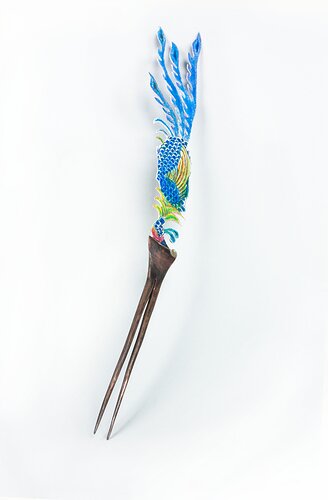Materials: Copper, gesso, and color panicle
Dimensions: 15" x 2" x 1/8"
When I think about color it reminds me of the traditional Chinese phoenix. It is so beautiful with all of its colorful feathers and the hair piece has always been the most important part in the history of Chinese jewelry. Although in traditional Chinese hair pieces, they always have one single color. In my opinion if there is only one color in your hair you should have a hair piece with multiple colors. This will cause be hairpiece to be more beautiful and stand out against your hair.
Photo credit: Lindsay Fisher
Shuying He Vogt
Jenison, MI. USA
I was born in China, came to America for school. After receiving my degree in Beijing, I discovered my passion for jewelry design and began looking at United States schools with that specialty. I found that at Grand Valley State. Beyond the jewelry and metalsmithing, I have the opportunity to strength my skills as a well-rounded artist. My art tells a story that helps me connect with people. I never appreciated traditional Chinese culture until I went back to visit last year. Although I was not raised traditional, I realized that my culture is disappearing. Chinese culture became my inspiration. I hope my art tells a story about my culture that helps me connect with people. Art is truly an international language.
The exhibition explores metal works whose primary theme is color embraced as their primary visual focus, whether that be using colored materials, exploring creating colored surfaces, or encasing the object in color.
As the world's largest jewelry related internet site, Ganoksin strives to develop exhibitions showcasing work from around the world. This exhibition was open to all metalsmiths, professional and amateur, advanced and beginner.
In total 303 artists contributed 814 show pieces for the permanent online exhibition.
The exhibition was curated by Beth Wicker, President of the North Carolina Society of Goldsmiths in the United States, and Adjunct Instructor at Northeastern Technical College in South Carolina. Director of the exhibition is Hanuman Aspler, founder of The Ganoksin Project, the world's largest internet jewelry site.
Hue is one of the primary properties of color, it refers to the place the color occupies on the visual spectrum. Humans have used hues throughout time, to create cave paintings, to decorate themselves, their clothing and their housing.
Different hues have taken on different meanings throughout time. Gold traditionally has been a color of purity - the metal gold is relatively unchangeable, and the hue of gold has come to stand for gods and goddesses, for royalty, for durability and for purity. Red has often meant love, or passion. Hues often reflect the meaning of the seasons, with pastels referring to spring and the burst of new life after the pale hues of winter. Summer is reflected in vibrant, deep hues, followed by the browning of hues in the fall as plants go to seed and die, and the land turns fallow.
The worth of a hue has often been tied to what is necessary to make the pigment that creates the hue, and the expensive involved in the process. Often created from crushed stones that had to be mined and carried by caravan over thousands of miles, or from fermented roots of plants only grown in certain areas, or the carapaces of rare insects - the creation of hue in a way that could be used by man was an involved and generally expensive process.
In today's world metalsmiths have access to perhaps the widest range of materials and hues in the history of man - and in some of the most affordable ways ever.
This exhibition celebrates hue - color - as an integral, inherent element of the work. We talk of the "richness" of color, and examples of this abound here. One expects hues from the colors of gemstones used in metalsmithing, but we also have hues from some less expected places. Glass enamels are an ancient way of adding color, as are a variety of patinas. Today's artists also use synthetic man-made materials to add color in ways that didn't exist a century ago.
We invite you to enjoy this celebration of hue, and the ways hues and their use have changed over time.
